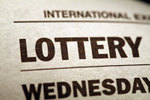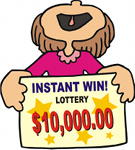You’ve Won The Lottery! Now What?


Friday the 13th was your lucky day. You won the lottery! The lottery officials have given you a choice. You can either receive the $10 million now in one lump sum, or you can receive $1 million a year for the next 20 years. Now what do you do?
Introduction
When lottery winners are announced, they are often pictured holding a giant check with large lottery winnings such as $180 million while photographers snap hundreds of pictures. Do the lottery winners actually get the amounts written on the checks at the time they win or do they get monthly payments?
 The answer to the question depends on the interest rate at the time of the winnings. In this lesson, you will show how the winner decides whether to take the winnings now or take the winnings in monthly payments depending on the interest rate.
The answer to the question depends on the interest rate at the time of the winnings. In this lesson, you will show how the winner decides whether to take the winnings now or take the winnings in monthly payments depending on the interest rate.
It is assumed in this lesson that your students have access to an Excel spreadsheet or a Ti-83 graphing calculator.
This lesson uses the concept of present value to teach the cost of immediate holding of money compared to later when someone wins the lottery. The concepts apply to many other intertemporal choices including whether to go to college or begin working. In this personal finance lesson, students will begin to understand the role of the interest rate in making choices.
Playing the lottery has a low probability of winning. This lesson is used to teach the concepts of present and future value and not to promote the playing of the lottery. This https://answers.yahoo.com/question/index?qid=20081017201927AASy801&guccounter=1 will provide students with more information about the probability of winning the lottery.
The use of present value and future value are used extensively in financial markets. For example, these concepts are used by consumers to decide whether to buy or rent. Students will find that they can make many financial decisions using these concepts including how to buy bonds and mortgages.
Learning Objectives
- Use technology to determine the best payoff in present value terms.
- Make predictions about the present value based on the interest rate.
Resource List
- Joe Wins the Lottery: Use the following link to introduce the concept of present value and how it is calculated by hand. This should give students a better intuition for the idea of present value.
econoclass.com/joewinsthelottery.html - Calculating and Understanding Real Interest Rates: The article introduces and demonstrates the concept of the real rate of interest to students.
https://www.thoughtco.com/calculating-real-interest-rates-1146229 - Present Value of an Ordinary Annuity: If you need a review on how to use your Ti-83 Graphing Calculator to find present value, visit the Texas Instruments website using:
https://education.ti.com/en/activity/detail?id=463FDEC9027D4D8595874102B73BC1F0ORLottery Solver: Distribute this PDF to the students to help them determine how to use the TVM Solver on the Ti-83+ to find the best payoff for winning the lottery, and how to use an Excel Spreadsheet to solve the lottery problem.
Lottery Solver
- Microsoft Excel as a Financial Calculator Part I: If you need a review on how to use Excel to find present value, visit The Microsoft Excel Time Value website.
www.tvmcalcs.com/calculators/excel_tvm_functions/excel_tvm_functions_page1 - Powerball’s Ohio Winners- Just Call Them ‘The Lucky 13’ Where Lottery Winners Work, It’s A Day To Play: This article is used in the Extension Activity to supplement the lesson.
https://www.courant.com/news/connecticut/hc-xpm-1998-07-31-9807310226-story.html - Yahoo! Answers: Link to explanation about the odds of winning the lottery.https://answers.yahoo.com/question/index?qid=20081017201927AASy801&guccounter=1
- About.com US government info: cites resources and information about lifetime earnings and their correlation with education levels.
https://www.thoughtco.com/lifetime-earnings-soar-with-education-3321730 - Present Value Table: The following table will show students how the change in the interest rate will change the present value of future money.
Present Value Table
Present Value Table Answers
Process
1. Use the following example from Econoclass.com to introduce the students to the concept of present value of money as it relates to the lottery.
2. To better understand the real effects of present value it is necessary to understand the impact of inflation on nominal returns on investments. When calculating the potential return on your investments (an annuity or other) one must also calculate the potential inflation rates. A high rate of inflation will negate your real returns on your investments. Check out the following article for an example https://www.thoughtco.com/calculating-real-interest-rates-1146229 .
3. Using the scenario at the beginning of this lesson and assuming an interest rate of 10%, have the students use their calculators or spreadsheets to find the present value of the lump-sum payout and the annuity. (The present value of $10 million right now is $10 million. The present value of $20 million in 20 payments of $1 million at 10% compounded yearly is $8.5 million. Taking the $10 million right now is wiser choice. Ti-83 > APPS > 1 > N=20 > 1% = 10 > PMT = -10000000 (10,000,000 write without commas) > P/Y = 1 > C/Y > 1 > PMT: END > ALPHA+ENTER. The formula in Excel is: =PV(0.1,20,-10000000)) NOTE: NEGATIVE SIGN IN FRONT OF $1,000,000 PAYMENT.
4. Change the interest rate to 8% and make the same calculations again. (If the interest rate is 8% then the present value is $12.46 million. This would be better choice at an 8% interest rate. Ti-83 > APPS > 1 > N=20 > I% = 5 > PMT = 10000000 > P/Y = 1 > C/Y > 1 > PMT: END > ALPHA+ENTER. The formula in Excel is: =PV(0.05,20,-10000000))
5. Discuss how the interest rate makes a difference in which option the winners choose. (The higher interest rate the less the future sum is worth now. The interest rate represents the opportunity cost of current consumption versus consumption at a later date. If the interest rate, which could be earned on the income now, is higher (10% v. 8%) than your potential future income will be higher because your investment will earn a higher return. Thus at some interest rate of return there will be a decision to make between taking the lump sum now or receiving payments. Note that when such a decision is made it can only be inferred at the time to be correct because of other factors which might influence the real rate of return, such as the inflation rate.) See Present Value Table
6. Have students predict the present value of the payout from a lottery when the interest rate is high. (The present value will be low. The present value of $1 at an interest rate of 10% is $.909. The present value of $1 at an interest rate of 20% is $.83. When the interest high, the present is low.)
7. Recently, John Stossel, has questioned the value of college. Describe how using present value to make choices about going to college or entering the workforce immediately. (When a student chooses to enter the workforce immediately after high school graduation, the student is discounting the future heavily. Income for high school graduates is lower than income for college graduates. This https://www.thoughtco.com/lifetime-earnings-soar-with-education-3321730 gives some data.)
Conclusion
The interest rate represents the opportunity cost between consumption now and later. The concept of present value equates future income with present when the costs and benefits arrive at different times. Students will find that using present value in their lives will help them to make decisions that maximize their income, earning, savings, investments, and utility.
The use of present value has many uses in accounting, investing, and making decision where the benefits arrive at different times. Recently, I bought a saving bond for $25. At maturity the bond will be worth $50. The government used present value to determine the length of time and interest rate on this bond.
Extension Activity
Read this story by Doug Alden, AP, July 31, 1998. The entire story is https://www.courant.com/news/connecticut/hc-xpm-1998-07-31-9807310226-story.html .
After years of pooling money to buy lottery tickets, a group of machinists who call themselves “The Lucky 13” stepped forward yesterday to claim the biggest prize yet – the $295.7 million Powerball jackpot.
One of the 13 workers at Automation Tooling Systems in this Columbus suburb drove 100 miles to buy 130 tickets just over the Indiana line for Wednesday’s drawing.
“It took a long time to believe we actually hit it,” said John Jarrell, a burly man with a long mustache who was the first of the 13 men to identify himself. “You go from totally excited to scared to death.”
The Lucky 13 will not officially be the winners until the Indiana lottery office validates the ticket. The jackpot was worth $295.7 million in payments over 25 years, but the winners took the cash option – one payment of about $161.5 million, Indiana lottery officials said. The Lucky 13 intend to split the money evenly, for $12.42 million per person before taxes, their lawyer said. If one multiplies $11.8 million by 25 years, the answer is $295 million. Assume that $295 million is the future value of the lottery winnings. If the interest rate is compounded annually for 25 years and the winners receive one payment a year, calculate the interest rate. [On your Ti-83, APPS, N=25, PV = 161,500,000, PMT = 11,800,000, FV = 0, P/Y = 1, C/Y = 1, PMT: END, move cursor to I% and ALPHA+ENTER. The Answer is 5.3%.]
Assessment
Your best friend has just won the scratch-off lottery that promises to pay him $30,000. Your friend has been told that he must take three yearly payments of $10,000 each. He knows that you have a huge savings account and says to you, “Here. I’ll give you my lottery ticket and you give me $30,000. It’s the same thing.” 
1. Evaluate your friend’s offer. (HINT: Economists like to say that a dollar today is worth more than a dollar tomorrow because the dollar today can earn interest.) [This would be a bad financial deal for you as you could invest the $30,000 now and have $30,000*(1.i)^3 later. If your only motive were to maximize the amount of money you have, you would be ill advised to make the deal.]
2. If the interest rate is 10%, calculate the present value of receiving $10,000 per year for three years, compounded annually. [$24,868.52]
3. If the interest rate is 5%, calculate the present value of receiving $10,000 per year for three years, compounded annually. [$27,232.48]
4. Should you take the lottery ticket if the interest rate is 10%? [NO]
5. Should you take the lottery ticket if the interest rate is 5%? [NO]
6. If the interest rate is high, say 20%, will the present value of a payment in the future be large or small? [SMALL]
